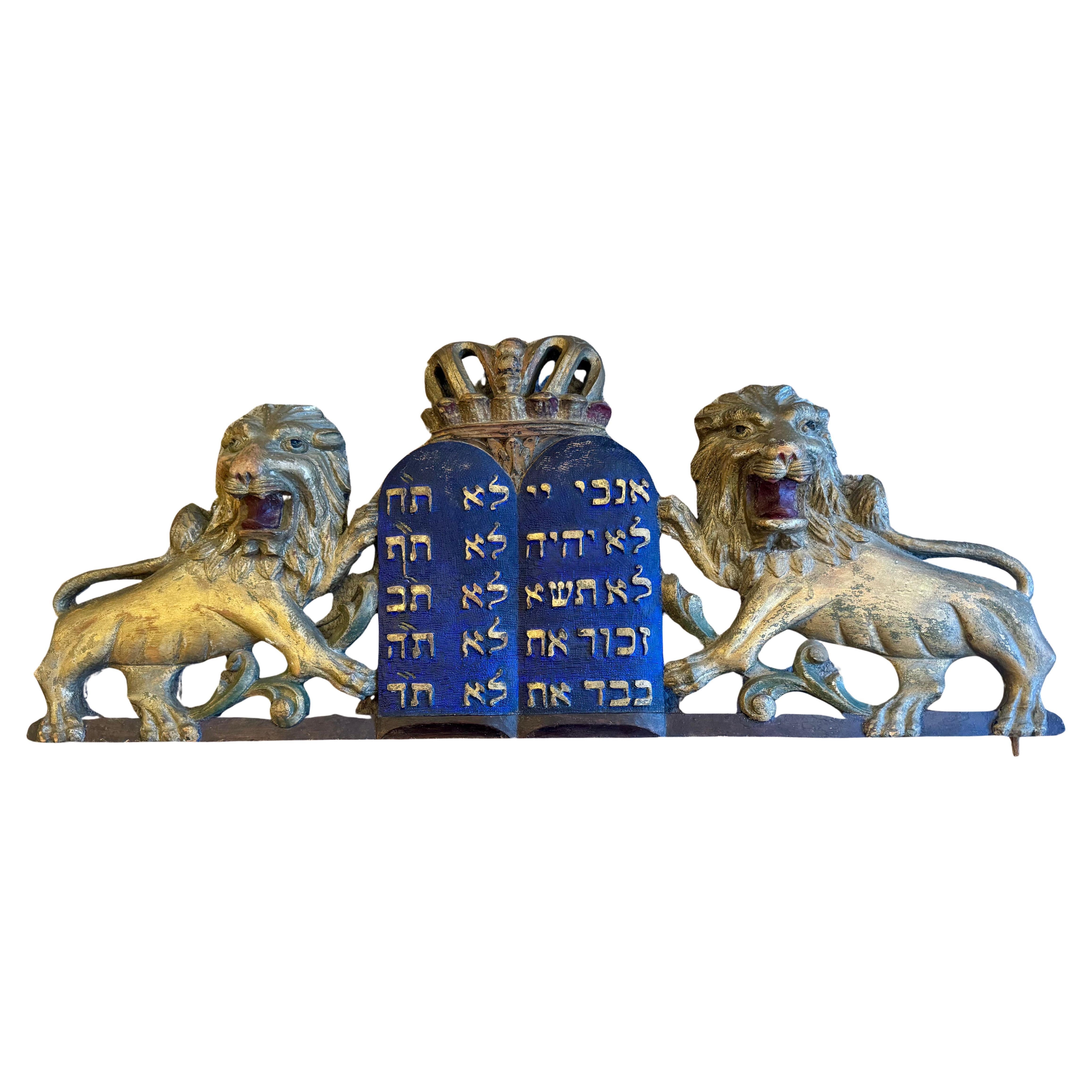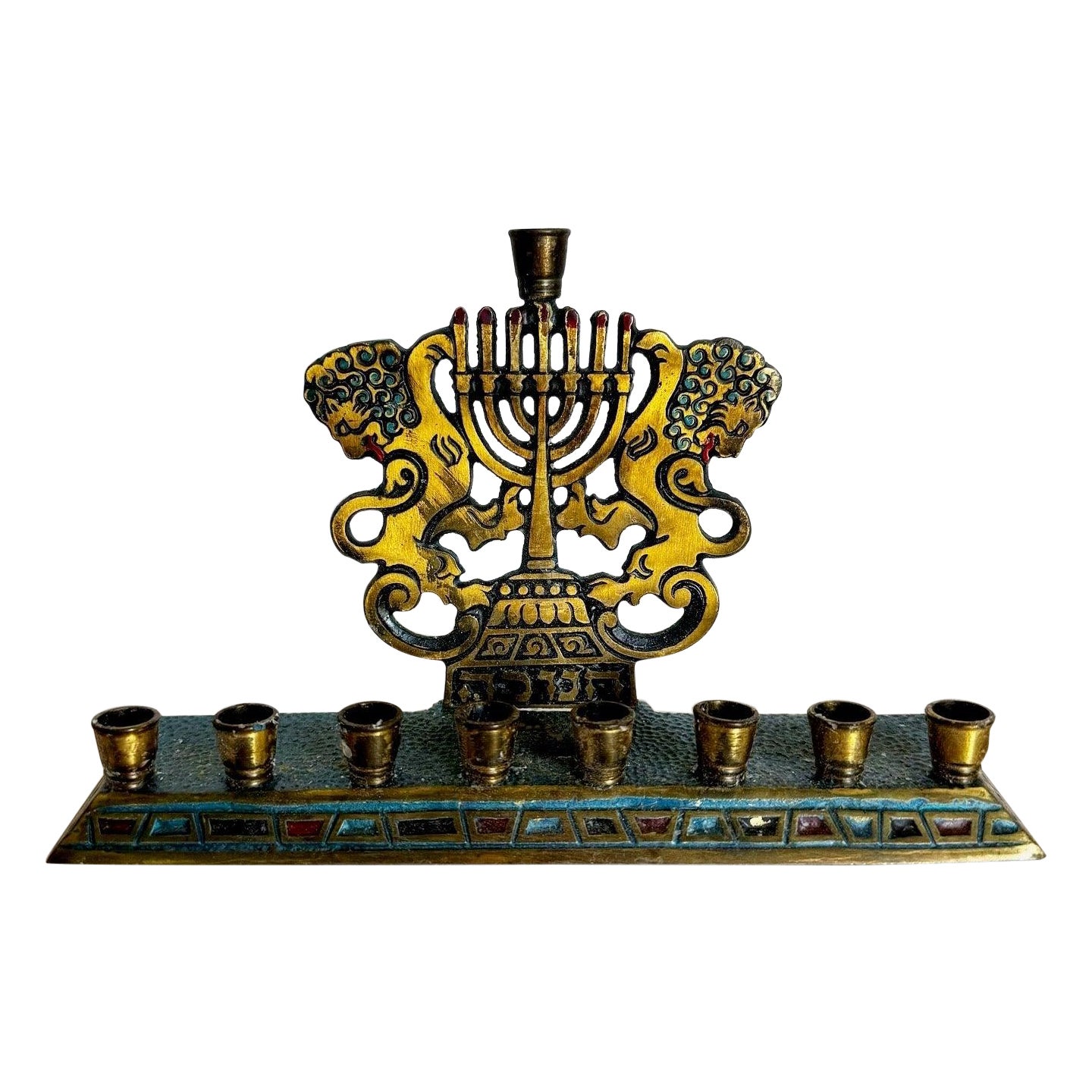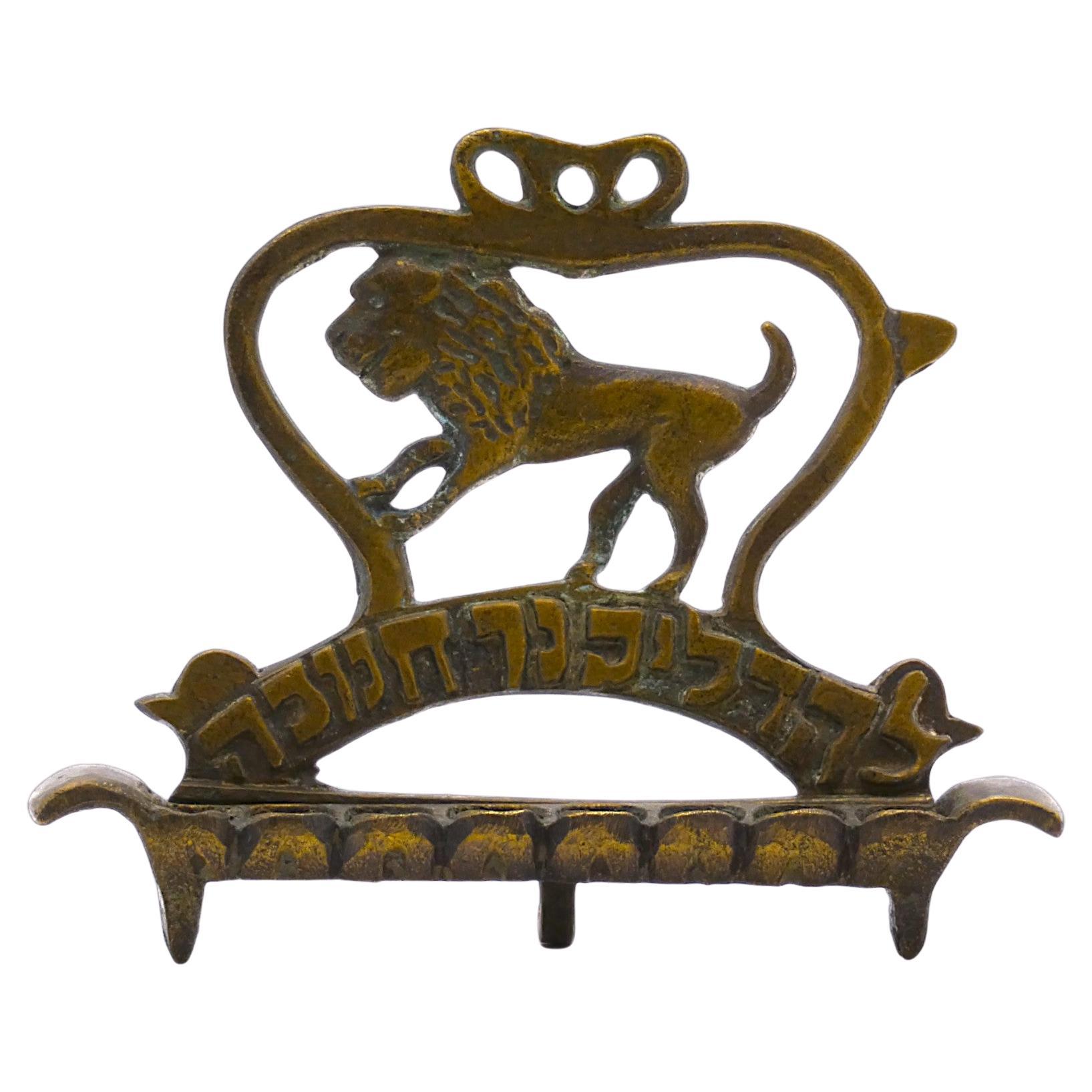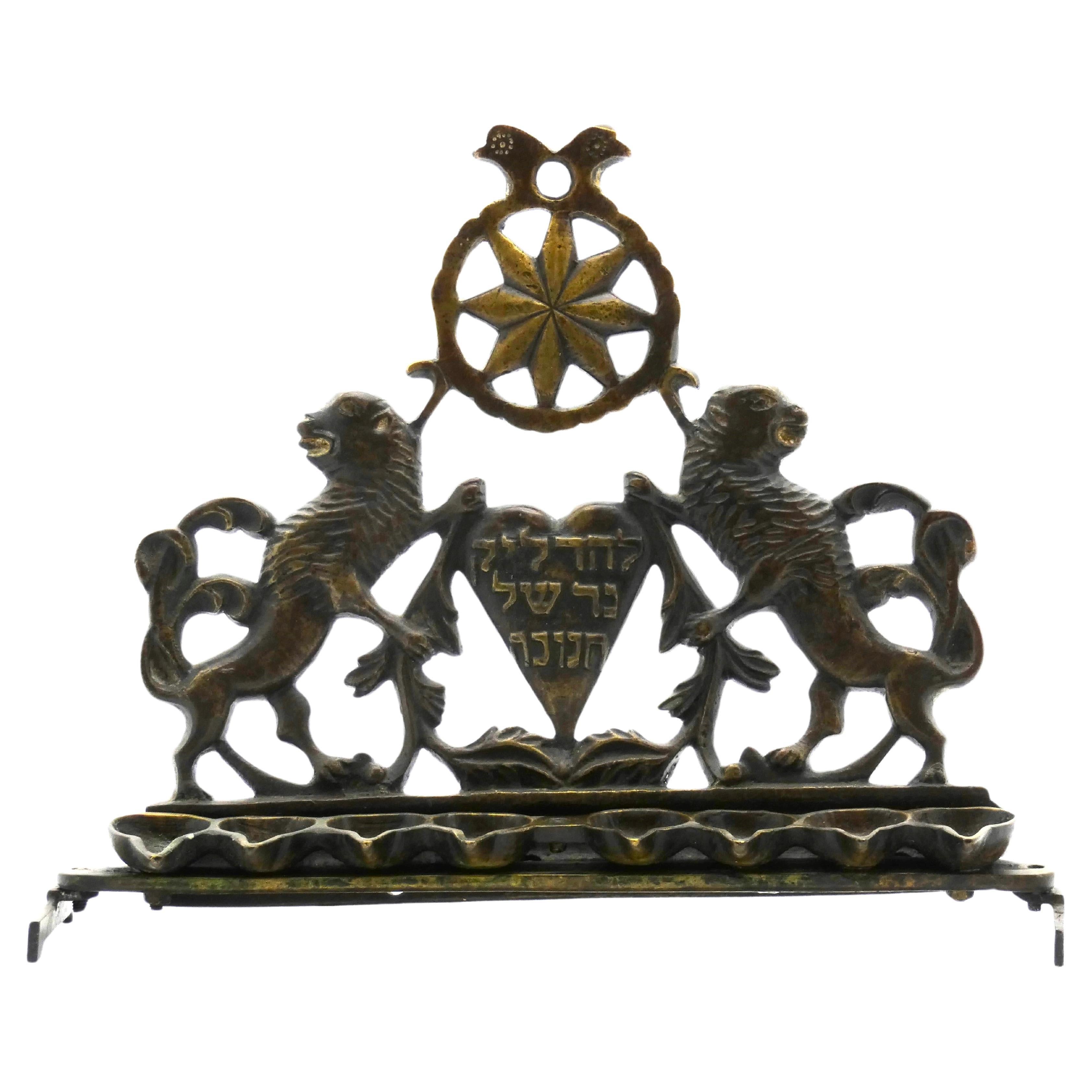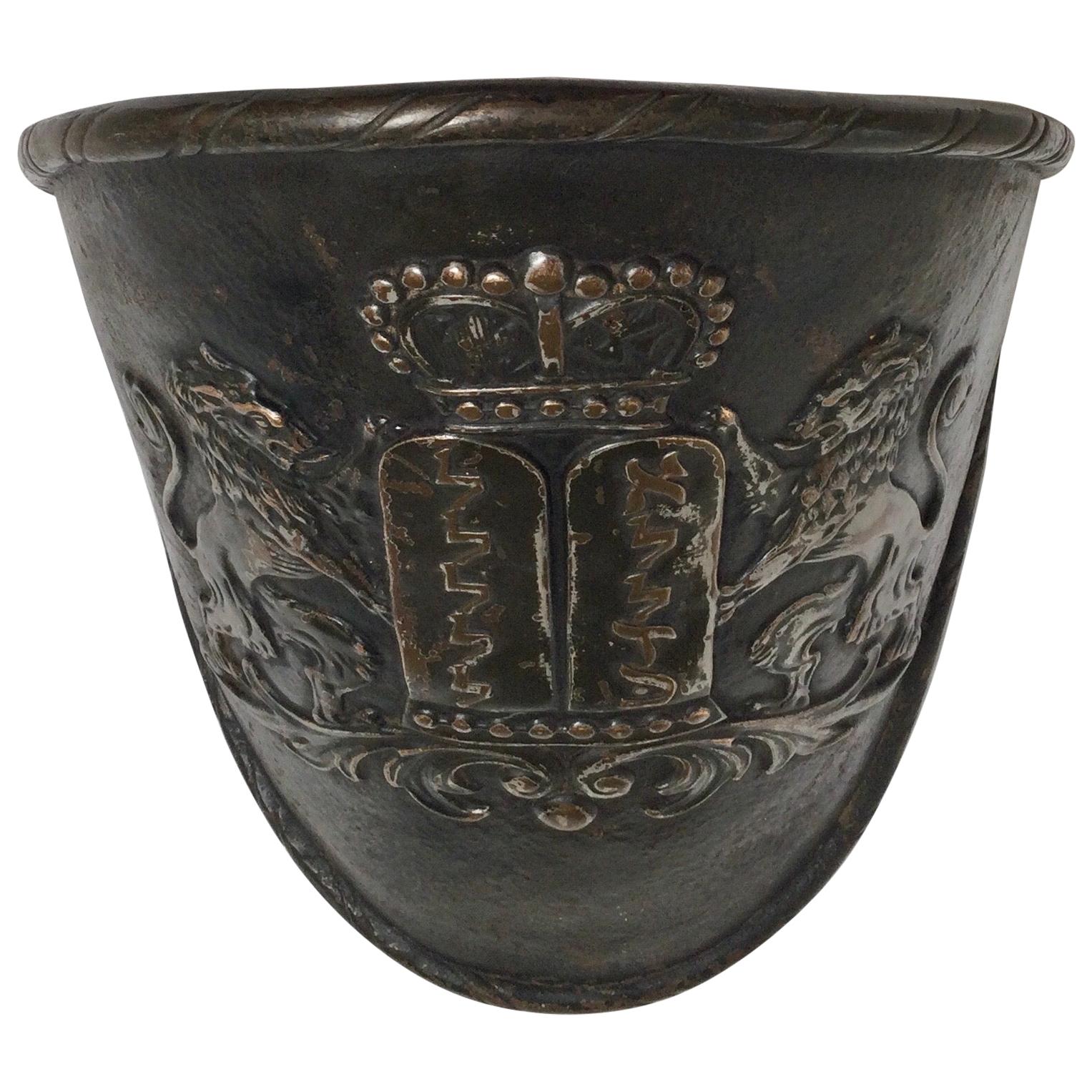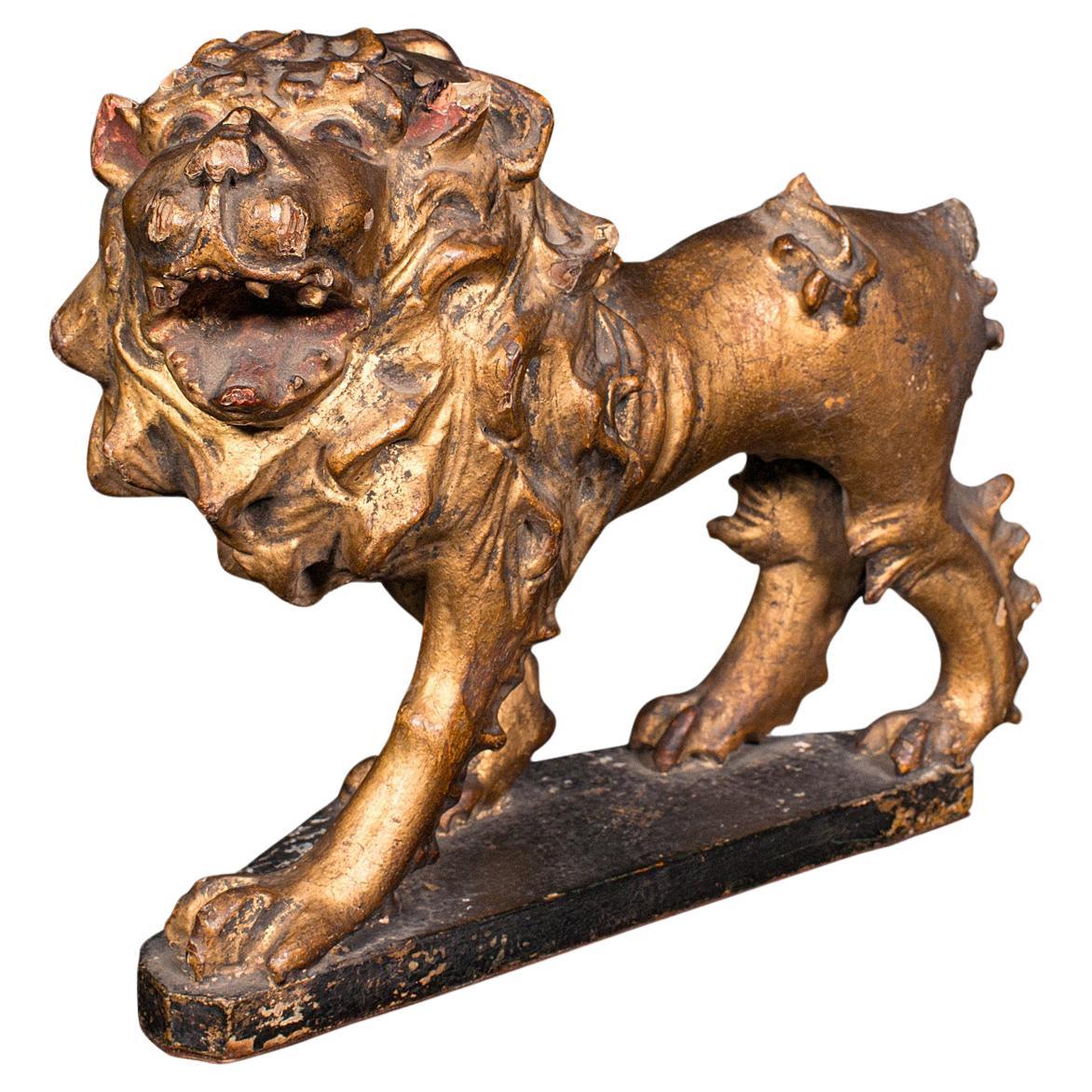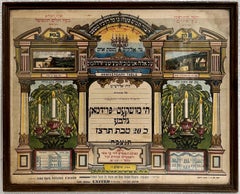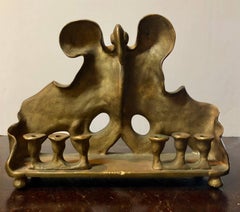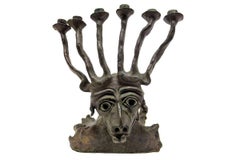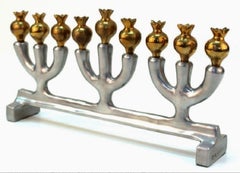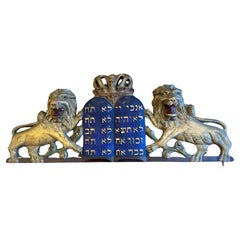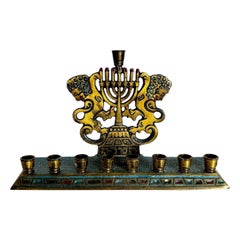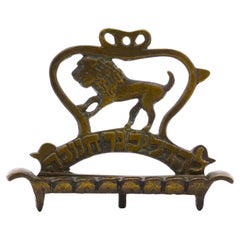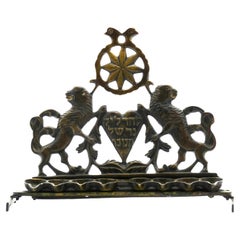Items Similar to Rare Folk Art Hebrew Judaica Carved Gilded Wood Lions Torah Synagogue Sculpture
Want more images or videos?
Request additional images or videos from the seller
1 of 20
UnknownRare Folk Art Hebrew Judaica Carved Gilded Wood Lions Torah Synagogue Sculpturec.1920's-1940's
c.1920's-1940's
$3,600
£2,708.06
€3,137.17
CA$5,075.25
A$5,644.02
CHF 2,961.81
MX$68,826.13
NOK 37,438.32
SEK 35,099.91
DKK 23,415.43
About the Item
Paint and gold paint on wood
Circa early to mid 20th century.
This is not signed
A treasure from a proud congregation. It is a hand-carved wooden sculpture showing the Tablets of the Law flanked by two Lions of Judah. Their paws held the tablets. Their roaring mouths faced outward, protecting the commandments from threats. In a foliage design with gold and silver paint.
Circa 1920-1940's. This Neoclassical, Judaic, Art Deco, Egyptian revival, Shul, Aron Kodesh hand carving, wood with gilding, Hebrew lettering ten commandments sign sculpture, was produced probably in New York.
There was a show at the Folk Art Museum titled “Gilded Lions and Jeweled Horses: The Synagogue to the Carousel” That featured these antique magnificent pieces. From gilded lions to high-stepping horses, the sacred to the secular, and the Old World to the New, “Gilded Lions and Jeweled Horses: The Synagogue to the Carousel” traces the journey of Jewish woodcarvers and other artisans from Eastern and Central Europe to America and the unsung role they played in establishing a distinct Jewish culture in communities throughout the United States. The exuberant artworks stand as a testament to a history of survival and transformation and provide a surprising revelation of the link that was forged between the synagogue and the carousel as immigrant Jewish artists transferred symbolic visual elements into this vernacular American idiom. The first major study of this important aspect of the Jewish contribution to American folk art, the exhibition features approximately one hundred artworks and objects, including rare documentary photographs of Eastern European synagogue arks and carved gravestones, sacred carvings, papercuts, and carousel animals. Some of these same Jewish European carvers worked on Coney Island amusement park rides and carousel horses and other carnival and circus carvings.
- Creation Year:c.1920's-1940's
- Dimensions:Height: 20.25 in (51.44 cm)Width: 38 in (96.52 cm)Depth: 1 in (2.54 cm)
- Medium:
- Movement & Style:
- Period:
- Condition:piece has minor wear and possible restoration in expected condition for its age and history. please see photos. it shows well.
- Gallery Location:Surfside, FL
- Reference Number:1stDibs: LU38216548822
About the Seller
4.9
Platinum Seller
Premium sellers with a 4.7+ rating and 24-hour response times
Established in 1995
1stDibs seller since 2014
1,794 sales on 1stDibs
Typical response time: <1 hour
- ShippingRetrieving quote...Shipping from: Surfside, FL
- Return Policy
Authenticity Guarantee
In the unlikely event there’s an issue with an item’s authenticity, contact us within 1 year for a full refund. DetailsMoney-Back Guarantee
If your item is not as described, is damaged in transit, or does not arrive, contact us within 7 days for a full refund. Details24-Hour Cancellation
You have a 24-hour grace period in which to reconsider your purchase, with no questions asked.Vetted Professional Sellers
Our world-class sellers must adhere to strict standards for service and quality, maintaining the integrity of our listings.Price-Match Guarantee
If you find that a seller listed the same item for a lower price elsewhere, we’ll match it.Trusted Global Delivery
Our best-in-class carrier network provides specialized shipping options worldwide, including custom delivery.More From This Seller
View AllRare Palestine Antique Hebrew Judaica Yahrzeit Synagogue Sign Memorial Plaque
Located in Surfside, FL
Circa 1890-1920. This Neoclassical, Judaic, Egyptian revival, Orientalist Mizrach sign, was produced in British Mandate Palestine by the chromolithograph process at the beginning of the 20th century. It pictures vignettes of holy places. with a hand written memorial. It was for the Tzedakah charity fund for the century-old institutions in Jerusalem: The great "Torah Center Etz Chaim"; a Free Kitchen for poor children and orphans; the famous Bikur Cholim Hospital with its dispensaries and clinics and the only Home for Incurable Invalids in Eretz Israel. They also worked with Arthur Szyk and Alfred Salzmann.. The A.L. Monsohn Lithographic Press (Monzon Press, Monson Press, דפוס אבן א"ל מאנזאהן, דפוס מונזון) was established in Jerusalem in 1892 by Abraham-Leib (or Avrom-Leyb) Monsohn II (Jerusalem, c.1871-1930) and his brother Moshe-Mordechai (Meyshe-Mordkhe). Sponsored by members of the Hamburger family, the brothers had been sent to Frankfurt, Germany in 1890 to study lithography. Upon returning to Jerusalem in 1892 with a hand press, they established the A.L. Monsohn Lithographic Press in the Old City of Jerusalem. According to the Information Center for Israeli Art A.L. Monsohn "created complex decorations for documents and oriental calendars that combined the tradition of Jewish art with modern printing techniques such as photographic lithography, raised printing and gilding."
The founders of the Monsohn press produced Jewish-themed color postcards, greeting cards, Jewish National Fund stamps, and maps documenting the evolution of the Jewish settlement in Eretz Israel in the nineteenth-twentieth centuries; religious material such as decorative plaques for synagogues, portraits of Old Yishuv rabbis such as Shmuel Salant, Mizrah posters indicating the direction of prayer for synagogues, memorial posters, and posters for Sukkot booths; color frontispieces for books such as Pentateuch volumes and the early song collections of Abraham Zvi Idelsohn (e.g., Shire Zion, Jerusalem 1908); artistic wedding invitations; and labels, packaging and advertisements for the pioneering entrepreneurs of Eretz Israel. The texts appearing in the Monsohn products were in several languages: Hebrew, Arabic, Yiddish, English, German (e.g., a c1920 trilingual Hebrew-English-Arabic "Malaria Danger" broadside warning the public of mosquitoes spreading malaria). Many of the brilliantly colored postcards and maps can be seen online as can the artistic invitations to his children's weddings which Monsohn published in the Jerusalem Hebrew press.
For years, the Monsohn (later, Monson/Monzon) Press was considered the best and most innovative in the country—pioneering in such techniques as gold-embossing and offset printing, among others. Early items for tourists included collections of Flowers of the Holy Land (c. 1910–1918)—pressed local flowers accompanied by scenes from the Eretz Israel countryside and relevant verses from the Bible, edited by Jsac Chagise (or Itzhak Haggis), an immigrant from Vitebsk, and bound in carved olive wood boards. Shortly after World War I Monsohn (now spelled מונזון) used zincography to produce the prints included in the Hebrew Gannenu educational booklets for young children illustrated by Ze'ev Raban of the Bezalel Academy of Art and Design and printed in Jerusalem by Hayim Refael Hakohen (vol. 1, 1919; vols. 2–3, 1920). In 1934 Monsohn moved into the new, western part of Jerusalem, in a shop with four presses and 30 workers, including Abraham-Leib's sons, David, Yosef, Moshe and Shimon, and his daughter Raytse's husband, Abraham Barmacz. The concern did business with all sectors of the city's population, including Arabs, for whom they printed in Arabic. Among their clients were members of the Ginio, Havilio, and Elite families, and Shemen, Dubek, and other renowned national brands, manufacturing products such as wine, candies, oil, and cigarettes. They also printed movie and travel posters, and government posters, postcards and documents, hotel luggage labels...
Category
Early 20th Century Aesthetic Movement More Art
Materials
Lithograph
RARE Judaica Holocaust Memorial Menorah Bronze Sculpture
By Mosheh Oved
Located in Surfside, FL
Moshe Oved (aka Edward Good) was a Polish-British, jeweler, artist, sculptor and Yiddish author and founder of the antique jewelry shop Cameo ...
Category
Early 20th Century Aesthetic Movement Figurative Sculptures
Materials
Bronze
RARE Judaica Brutalist Animal Holocaust Memorial Menorah Bronze Sculpture
By Mosheh Oved
Located in Surfside, FL
Moshe Oved (aka Edward Good) was a Polish-British, jeweler, artist, sculptor and Yiddish author and founder of the antique jewelry shop Cameo Corner. He le...
Category
Early 20th Century Aesthetic Movement Figurative Sculptures
Materials
Bronze
Rare Oded Halahmy Cast Sculpture Art Menorah Artisan Judaica in Jewish Museum
Located in Surfside, FL
Oded Halahmy (Iraqi-Israeli, b. 1938)
Bronze and aluminium
"Peace Shalom Salaam" Hanukkah/ Chanukah menorah, 1997
The base signed on one side with his stamped initials, "O.H. © 97."
This simple pomegranate menorah by Iraqi art...
Category
Early 2000s Pop Art Figurative Sculptures
Materials
Metal
Wool Felt Applique Israeli Folk Art Lion Signed Tapestry Kopel Gurwin Bezalel
By Kopel Gurwin
Located in Surfside, FL
This tapestry depicts a Lion, In Hebrew Mazel Aryeh (the Zodiac symbol Leo,) all handmade. woven and stitched.
Kopel Gurwin (Hebrew: קופל גורבין) (1923–1990) was an Israeli tapest...
Category
20th Century Folk Art Mixed Media
Materials
Wool, Felt
Large Judaica Copper Repousse Sculpture Relief Plaque Arie Merzer Bezalel Era
By Arieh Merzer
Located in Surfside, FL
Arieh Merzer (Israeli, 1905-1966)
Copper relief sculpture panel in gilt frame
Framed dimensions 18 X 26.25, copper 14.5 X 22.5
Arieh Merzer ...
Category
Mid-20th Century Figurative Sculptures
Materials
Metal, Copper
You May Also Like
Judaica: An Antique American Decalogue
Located in Montreal, QC
This unusual pediment is from the top of an ark, it is original down to the pegs that would attach it except a very minor refreshing of the blue paint. The tablets are carved in r...
Category
Antique Late 19th Century Sculptures and Carvings
Materials
Pine
Israeli Brass “Lions of Juda” Menorah/Chanukia
Located in Delray Beach, FL
Israeli Brass Lions of Judah Menorah with hand-painted accents and hammered texture. Perfect for Hanukkah or as a stunning decorative piece.
We sell i...
Category
Vintage 1970s Israeli Religious Items
Materials
Brass
A 19th Century Polish Brass Hanukkah Lamp
Located in New York, NY
A 19th Century Polish Brass Hanukkah Lamp.
The cast backplate presents a pierced lion leaning on one side of an outlined majestic crown.
"To light the candle of Hanukkah is written...
Category
Antique 19th Century Polish Candle Lamps
Materials
Brass
$1,600 Sale Price
20% Off
A Brass Hanukkah Lamp, Prague late 18th century
Located in New York, NY
This spectacular Hanukkah lamp is ornately fashioned with a cast backplate featuring a heart shape at center flanked by two rampant Lions of Judah fiercely facing away from one anoth...
Category
Antique Late 18th Century Czech Baroque Candle Lamps
Materials
Brass
Early Judaica Wall Sconce Ten Commandments & Lions of Judea, with Torah Crow
Located in Lambertville, NJ
Early Judaica wall sconce, ten commandments and Lions of Judea, with Torah Crown (in the style of Arthur Syzk) This bronze wall sconce depicts two of the...
Category
Mid-20th Century German Wall-mounted Sculptures
Materials
Bronze
Antique Carved Lion Figure, English, Giltwood, Decorative Ornament, Mid Georgian
Located in Hele, Devon, GB
This is an antique carved lion figure. An English, giltwood decorative desk or mantle ornament, dating to the mid Georgian period, circa 1750.
Charm...
Category
Antique Mid-18th Century British Georgian Sculptures and Carvings
Materials
Giltwood
